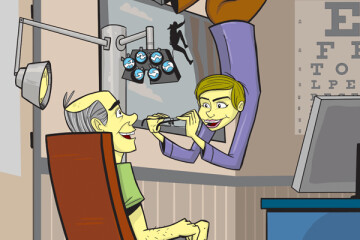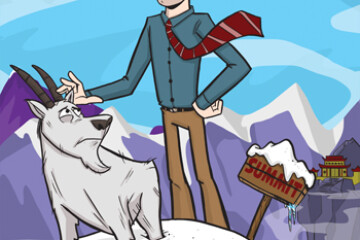Featured Bozemanite: Howard Steven Moore
 When I met Howie, I wondered if his near-death experiences changed him. Did stretching for air through the tumbling rocks and the solidifying concrete of an avalanche alter the course of his life? I pondered the affects of a potentially life-threatening, chronic disease. I couldn’t fathom the fundamental changes from such a diagnosis.
When I met Howie, I wondered if his near-death experiences changed him. Did stretching for air through the tumbling rocks and the solidifying concrete of an avalanche alter the course of his life? I pondered the affects of a potentially life-threatening, chronic disease. I couldn’t fathom the fundamental changes from such a diagnosis.
What you already know: The 42 year-old Howard Steven Moore goes by “Howie” though for years he was known professionally as “Steve.” His smile is contagious. He’s quick to laugh. He still finds boyish humor exceedingly entertaining. He’s kind and inclusive. His friends are his family and his family is his heart. He’s easy going and easy to talk to. You’ve seen him carving tele turns in the backcountry, floating the Madison, or on the ice at Haynes Pavilion. You might know Moore as the “beer guy” for Madison River Brewing Company. What you don’t know about Moore might inspire you.
Born in Dallas, Texas, there’s no residue of Moore’s southern roots—probably because he spent his childhood in Portland, Oregon. Among the foothills and peaks of Mount Hood, Moore’s love for nature and adventure set roots in his heart. Skiing, camping, and mountain biking—lust for the outdoors would eventually steer his future in ways he couldn’t predict.
Moore recalls feeling “different, different than most” as a little boy. “I recognized as a little guy that people lived by certain expectations. I remember thinking, ‘that doesn’t apply to me.’ I never thought the rules applied.”
Moore’s resistance to rules percolated into an internal drive to stretch his own limits. For him, it meant he could practice harder, work longer, and go farther. He stretches the length of a day; he stretches the days in a week, and the weeks in a year.
From a young age, Moore was an athlete, playing competitive tennis, competing in triathlons, and a rising star in soccer leagues. When he moved back to Dallas to attend Richland Junior College, he impressed bigger schools by garnering the title of leading scorer both years. He was hungry to maximize the experience and grow as a player. It wasn’t long before the University of Arkansas offered him a full-ride academic and athletic scholarship to play Division 1 soccer. Before finishing college with a degree in psychology and health education, the midfielder was picked up by a semi-pro soccer league—the Arkansas A’s—where he played until it was time to stretch in a new way.
After college, Moore longed to be closer to wild things and out of the Texas heat. He moved to Alaska to spend a summer at a fish processing plant. With no vehicle, he walked passed brown bears to get to work and watch the never-ending light of day dance on the horizon on his walk home. Like Moore’s innate nature, summer days in Alaska stretched to absolute limits.
Unsure of the next step, Moore thought about taking a year off. He considered following the Grateful Dead before his plans abruptly shifted with Jerry Garcia’s death in 1995. This seemingly unrelated moment in time brought Moore to Bozeman. With no band to follow, the only certainty was a need to be near mountains.
Like any true Bozemanite—whether native or transplant—he took on the big sky with fervor. Ice climbing, kayaking, skiing—the longer the day, the greater the distance, the more challenging the task, Moore tested and stretch his own abilities. But, the nearly-silent whispering of genes was already beginning to tap on his door.
In 1996, he moved back to Portland to temporarily care for his father who was recovering from brain surgery. The massive tumor was result of VHL, or Von Hippel Lindau, a rare genetic disease that causes cancerous and noncancerous tumors to grow. Patients spend a lifetime battling tumors in the brain, spine, kidneys, pancreas, eyes, and adrenal glands.
Watching his father relearn how to function post-brain surgery was a stark reminder that he was susceptible to a similar future. VHL didn’t wait much longer to make its entrance into Moore’s life.
It came on as extraordinary energy and anxiety. Running ten miles wouldn’t diminish an ounce of energy. When Moore started to feel panicky at a grocery store, he knew something was wrong. He scheduled an appointment to see a doctor. Numerous tumors filled both his adrenal glands. His future shifted in a moment.
The diagnosis was numbing. Even though Moore knew he was predisposed, nothing really prepares you to hear the diagnosis of a life-long battle with tumors. The adrenal tumors needed to be addressed immediately and by the watchful eye of his mother, he found his way to the National Institutes of Health in Washington DC.
Moore enrolled in various studies because VHL is so rare. This gave him access to cutting edge treatments. When he came out of his first surgery, he felt strangely powerful.
“I felt like I just won. Those tumors were gone. I won the battle!”
Moore returned to Southwestern Montana shortly after surgery. The feeling of empowerment faded into deep introspection, often from the peak of a mountain. The reality of his disease—that cancer and tumors would rear their ugly heads time and again—made the sunsets seem more important and the sunrises seem worth a 4 a.m. alarm. It intensified his natural tendency to push his body, to explore deeper canyons, to climb higher mountains.
Over the next ten years, Moore set an impressive pace. He managed a group home, built trails for Montana Conservation Corps, got a Master’s degree from MSU, became a Licensed Clinical Professional Counselor, was a school counselor, worked with troubled youth wilderness therapy programs in Montana and Idaho, helped design and launch a wilderness therapy program near Bozeman, and had a private practice. Moore did all these things while fitting in numerous scans, doctors’ appointments, and surgeries.
Despite his extraordinary professional pace, Moore made a point to put energy into personal interests. He bucked the idea that successful adulthood meant a nine-to-five lifestyle, even if he occasionally worked a nine-to-five job. He woke before dawn to ski the backcountry slopes before work. He hit the mountain bike trail after work, returning by headlamp after dusk. He devoted time to friends and family that brought him happiness and laughter.
Moore was thoughtful of filling his days with things he genuinely loved before his diagnosis. VHL solidified his commitment to live authentically; it impassioned his desire to make time for the activities and people that brought him joy. The mountains were his temple, a place for solace and strength.
Life has a tendency to toss out speed bumps at times. Moore’s first was in 1999 when he was caught in an avalanche near Cooke City. After his brother and friends miraculously found and dug-out Moore, he gazed up at the debris field. The crown topped out at 12 feet and a rocky cliff was exposed by the wide slide.
“I couldn’t believe I went over the rocks. I couldn’t believe I was alive,” said Moore.
He returned to his break-neck speed shaken but with a new understanding about living. Maximize days, stretch personal limits, but do it all with one eye on safety. It was just what he needed—a reminder to not be careless with his life—as Moore continued to live as fully as he could muster.
Many years later, as an experienced and respected therapist directing wilderness therapy programs near Bozeman, Moore received a second pace adjustment. Working eighty hours a week, life became unbalanced. He was a few months from the next scheduled surgery when the program closed and he was out of work.
Exhausted, Moore opted to spend some much needed time regaining strength and energy in the Montana mountains before facing another long recovery. After 120 days of backcountry skiing, he arrived in Washington DC for surgery, rejuvenated and ready for battle.
Watching the ceiling tiles slip by and chatting with the nurse on the way to his final, pre-op scan, Moore couldn’t have imagined what would happen next. His body marked for surgery, he expected transport to the operating room when his doctor came instead.
“We’re cancelling the surgery. Your tumors stopped growing.”
Shocked, Moore returned to Montana. What stopped the tumors? Was it the skiing? The end of intense professional stress with the closing of the therapy program? The complete focus on filling his day with joyful turns?
Despite the years invested in his career, Moore had only one choice. We live once. He intended to maximize the one opportunity he’s been given. It was time to add something new into his regimen: Balance. Though it was rewarding, he stopped practicing therapy. The lifestyle change bought Moore three years before needing that surgery.
Moore is someone who risks change, who walks through unexpected doors in search of authenticity. He purposefully builds joy, love, and laughter into each day. He’s always pushing. Searching for the end of a trail. Reaching for the dawn start with fresh skin tracks. He does these things for the joyful swell it gives his heart.
The surprise is that these experiences didn’t actually change Moore. Instead, they intensified who he was already. Facing his mortality, Moore found deep self-acceptance and love.
Maybe Moore’s greatest gift is a deep awareness that we have one life—one beautiful, challenging, incredible life. It’s given him the well-won maturity to know himself completely. And so he stretches his fingertips around the Montana sun and lives in a way we all hope to live. Howie is unapologetically Howie, and he is alive.
Howie Moore lives in the Gallatin Valley with his partner-in-life, who he affectionately refers to as his “Special Lady Friend” (The Dude would approve), and his sixteen year-old pup, Ned.
“Montana People” is a new series in the Bozeman Magazine. Monthly, it will feature a Montanan with an unexpected story. If you know someone with an interesting story, please email ideas to info@bozemanmagazine.com
Liz Krause Williams is a professional story teller, resume writer, LinkedIn profile writer, and copywriter helping job seekers and brand-building professionals move forward with confidence as they pursue career ambitions. Learn more at www.occupationinnovation.com and follow Liz at facebook.com/occupationinnovation.






